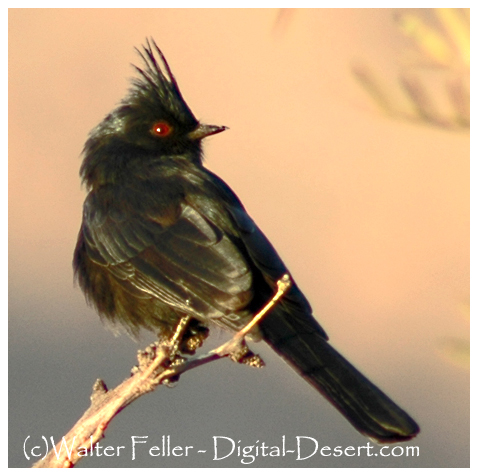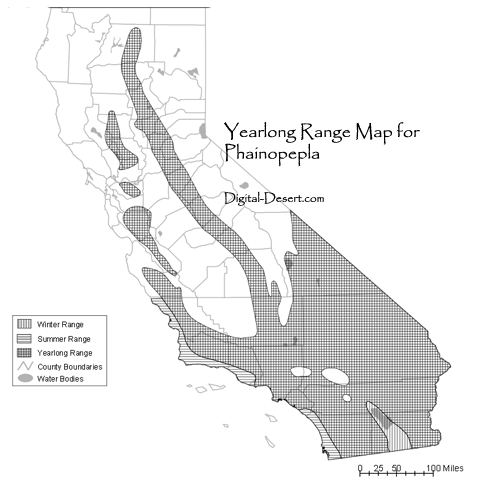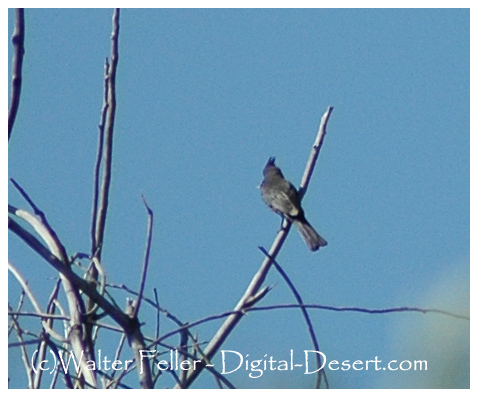Phainopepla
Phainopepla nitensFamily: PTILOGONATIDAE
Order: PASSERIFORMES
Class: AVES
DISTRIBUTION, ABUNDANCE, AND SEASONALITY
Present year-round in California; resident and winter visitor in south, mostly a transient and summer visitor in north. Common in southern deserts, fairly common in southern foothills, and uncommon to locally fairly common around margins of the Central Valley, in bordering foothills, and inner Coast Ranges. Frequents open woodlands of oaks and other small trees, shrubs and chaparral; often associated with mistletoe berries. Highest density occurs in sparse palm oasis, desert wash, and desert riparian habitats; also fairly common to uncommon in valley foothill hardwood, valley foothill hardwood-conifer, mixed chaparral, and orchard-vineyard habitats. Local occurrence is irregular and unpredictable. Much of the population in southern deserts reported to leave from early May through September, moving to more western and northern parts of range. Evidence suggests that some individuals may nest first on southern deserts and again in summering area in the same year (Hoffmann 1927, Grinnell and Miller 1944, McCaskie et al. 1979, Garrett and Dunn 1981, Ehrlich et al. 1988).SPECIFIC HABITAT REQUIREMENTS
Feeding: Berries are the major food; also eats small insects, especially in nesting season. Nestlings fed both insects and berries. In California, heavily dependent on mistletoe berries (Grinnell and Miller 1944, Garrett and Dunn 1981) growing on mesquite, acacia, ironwood, cottonwood, blue oak, live oaks. Other important berries include juniper, elderberry, grape, buckthorn, poison-oak, and the introduced pepper-tree. Hawks insects in air, often by sallying from a high perch. Picks berries by clinging to clusters or hovering.Cover: Trees and large shrubs provide cover.
Reproduction: Nests in dense foliage of a tree or large shrub, sometimes in a clump of mistletoe.
Nest built 1.3 to 15 m (4-50 ft) above ground, usually 1.8 to 3.4 m (6-11 ft). Frequently nests near a berry source.
Water:
No additional information found.
Pattern: Frequents low-elevation woodlands with scattered trees, understory, or adjacent dense shrubs, and a source of berries.
SPECIES LIFE HISTORY
Activity Patterns: Yearlong, diurnal activity.Seasonal Movements/Migration: Resident and winter visitor in southern California. Most move out from southern deserts in April or May, moving to more western and northern parts of California. Most return to the deserts by September or October.
Home Range: Van Velzen (1977) reported density of 36 territorial males or females per 40 ha (100 ac) in desert wash habitat, and 74 per 40 ha (100 ac) in desert riparian habitat in San Bernardino Co.
Territory: In Imperial Co., territory varied from 0.2 to 0.6 ha (0.5 to 1.5 ac) and averaged 0.4ha (1 ac) (Walsberg 1977). In desert riparian habitat along the Lower Colorado River in Arizona, territory varied from 0.59 to 1.03 ha (1.5 to 2.6 ac) (Laudenslayer 1981).
Reproduction: Nests late February into April in deserts, and late May to late July in western and northern areas (Bent 1950). A monogamous, solitary nester; clutch size 1-4, average 2.5. May raise a brood on southern deserts and another after moving to summering area (Garrett and Dunn 1981). Incubation lasts 14-15 days. Altricial young tended by both parents and leave nest at 18-19 days. Young probably breed first at 1 yr (Harrison 1978).
Niche: Defends fruiting mistletoe from other species (Walsberg 1977).
REFERENCES
Bent, A. C. 1950. Life histories of North American wagtails, shrikes, vireos, and their allies. U.S. Natl. Mus. Bull. 197. 411pp. Crouch, J. E. 1943. Distribution and habitat relationships of the phainopepla. Auk 60:319-333. Ehrlich, P. R., D. S. Dobkin, and D. Wheye. 1988. The birder's handbook. Simon and Schuster, New York. 785pp. Garrett, K., and J. Dunn. 1981. Birds of southern California. Los Angeles Audubon Soc. 408pp. Grinnell, J., and A. H. Miller. 1944. The distribution of the birds of California. Pac. Coast Avifauna No. 27. 608pp. Harrison, C. 1978. A field guide to the nests, eggs and nestlings of north American birds. W. Collins Sons and Co., Cleveland, OH. 416pp. Hoffmann, R. 1927. Birds of the Pacific States. Riverside Press, Cambridge, MA. 353pp. Laudenslayer, W. F., Jr. 1981. Habitat utilization by birds of three desert riparian communities. Ph.D. Thesis, Arizona State Univ., Tempe. 148pp. McCaskie, G., P. De Benedictis, R. Erickson, and J. Morlan. 1979. Birds of northern California, an annotated field list. 2nd ed. Golden Gate Audubon Soc., Berkeley. 84pp. Rand, A. L., and R. M. Rand. 1943. Breeding notes on the phinopepla. Auk 60:333-341. Van Velzen, W. T., ed. 1977. Fortieth breeding bird census. Amer. Birds 31:24-93. Walsberg, G. E. 1977. Ecology and energetics of contrasting social systems in Phainopepla nitens (Ptilogonatidae). Univ. Calif. Publ. Zool. 108:1-63
Also see:
Phainopepla and Desert Mistletoe: Desert Wash Environment
The relationship of the phainopepla and mistletoe berries - Plants in the Desert Wash Habitat of Joshua Tree.
Mistletoe - Bajada Nature Trail
The berries are a major winter food source for the phainopepla, a black, crested bird, who in turn spreads the seeds to other trees where a new plant can ...
Desert Wash - Desert Habitats
Mistletoe attracts phainopepla, a small tufted black bird that eats--and disperses--its berries. Water attracts many other birds, including migratory ...
Juniper with Mistletoe
Joshua Tree National Park, the Mojave Desert - Cap Rock Interpretive Trail.

Male phainopepla

Range map

Female phainopepla